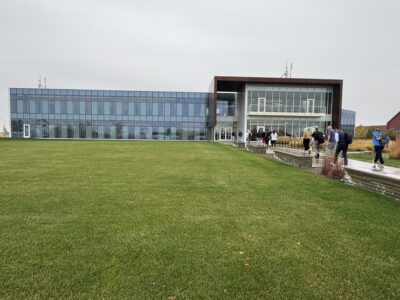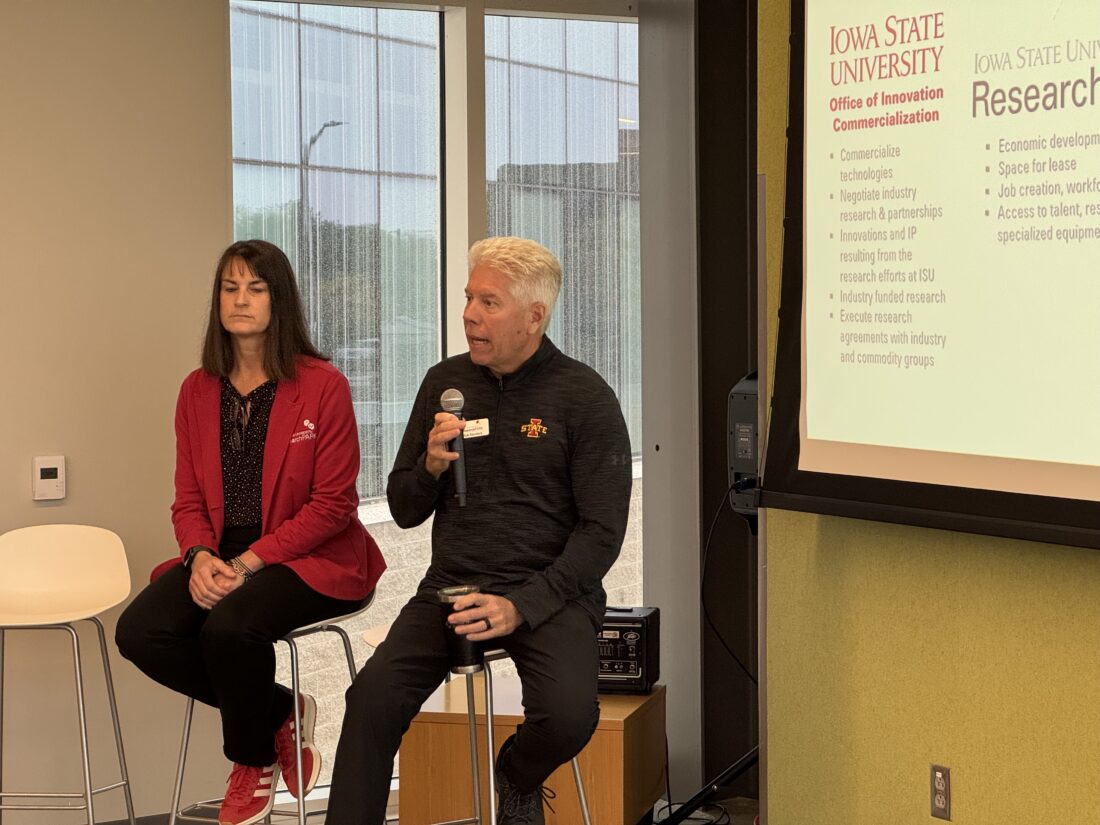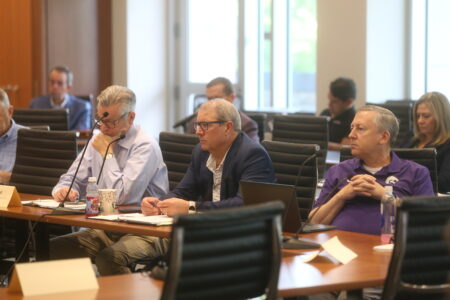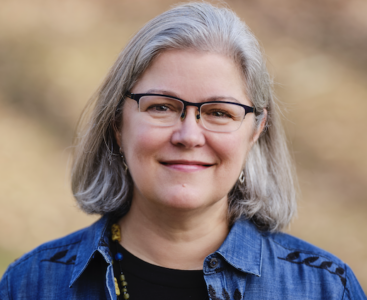
From cornfields to corporations, Lawrence leaders hear how Iowa State has built a $100M university business park
Chamber of commerce delegation exploring Ames, Des Moines

photo by: Chad Lawhorn/Journal-World
Members of a Lawrence delegation enter the headquarters building of the ISU Research Park on Oct. 14, 2025.
Ames, Iowa — Iowa cornfields already have a reputation for building it and they will come.
Lawrence and Douglas County leaders in Iowa for a chamber of commerce intercity visit on Tuesday weren’t interested in the baseball — “Field of Dreams” — version of that story. Instead, they were more interested in learning what happened when an Iowa cornfield got torn up and reimagined as a business park.
In 1987, leaders at Iowa State University identified a 40-acre cornfield on the outskirts of Ames, and began planning for how it could become a university research park. Today, the business park has about 1,000,000 square feet of office and research space in 22 buildings spread across 550 acres. In total, the park has about $100 million in assets and hosts about 140 companies and 2,500 employees.
Those are a lot of numbers, but one that stood out to Lawrence leaders was the year 1987. That’s about 20 years before the University of Kansas truly began its efforts to attract corporations and their research teams to KU’s West Campus.
That left local leaders hoping the Ames project had given them a glimpse at Lawrence’s future as KU continues to develop The Crossing project on its West Campus.
“We’re about 18 years old and they’re about 38 years old, so I think we’re heading in the right direction,” Adam Courtney, chief executive of KU Innovation Park, told me as part of Tuesday’s tour.
Innovation Park has undertaken three separate building projects on West Campus to provide incubator space for start-up companies and also for well-established companies that want to be close to KU students and KU researchers. Innovation Park has served about 75 companies over the years, and has just under 800 jobs in the program, Courtney said.
The park has a goal of having 4,000 jobs when it is fully developed.
The Lawrence delegation on Tuesday heard that in Ames they have thought both big and small to get to their numbers. The park does provide services and very cheap office space — $200 per month — to start-up companies.
But the university also has made it clear that the ISU Research Park isn’t just about fostering start-up companies. The park is home to dozens of large companies, including multiple publicly-traded companies. Those include John Deere, which has two facilities in the park, including one that does design work for sprayers that are tested in cornfields that still abut the research park.
Alison Doyle, associate director at the ISU Research Park, said Iowa State leaders have recognized that the university has a big advantage over traditional business parks: The park doesn’t just have land to offer, but also have new employees to offer businesses.
“We churn out 8,000 graduates every year, right?” Doyle told the tour attendees.
Doyle said “talent attraction” has been a key ingredient in the “secret sauce” for the park’s success. The park has tried to squeeze every ounce of juice out of that advantage by creating a unique internship program. Instead of having individual companies hire ISU students as interns, the research park technically hires the interns on behalf of the companies. That allows the research park to take care of all the administrative duties, such as payroll, workers compensation insurance and other such issues. The research park pays students an agreed-upon hourly rate, and then bills the company monthly for those hours, plus a 10% administrative fee. The program was designed for start-up companies that often don’t have a human resources department. The program has been popular with start-up companies, but Doyle said it is now most heavily used by the larger companies, which are finding that the process makes it much easier to add interns as opportunities arise.
The ISU park has taken the approach a step further, and now is working on a program that convinces those interns to remain with those companies after graduation. Doyle said the park’s companies had been frustrated that many interns were getting swept up by companies from the coasts after graduation.
The staff at ISU Research Park tackled that problem by doing more outreach with students, and helping the park’s companies highlight what they have to offer. The research park also has begun offering a money-back-guarantee to companies who ultimately aren’t able to convince an intern to join the company.

Alison Doyle, associate director of the ISU Research Park, and Rick Sanders, president of the park, talk to a Lawrence delegation on Oct. 14, 2025.
Rick Sanders, president of the ISU Research Park, told the Douglas County delegation that the money-back-guarantee is an example of how the research park spends a lot of time thinking about the finances of the companies in the park.
“We look at everything through the lens of ROI (return on investment) for the entities that we deal with,” Sanders said.
That too has been part of the secret sauce of the growth of ISU Research Park, he said.
“The interesting thing is when you start to provide that ROI, the word gets out pretty quickly,” Sanders said. “And once the word gets out, you start seeing more and more and more companies.”







